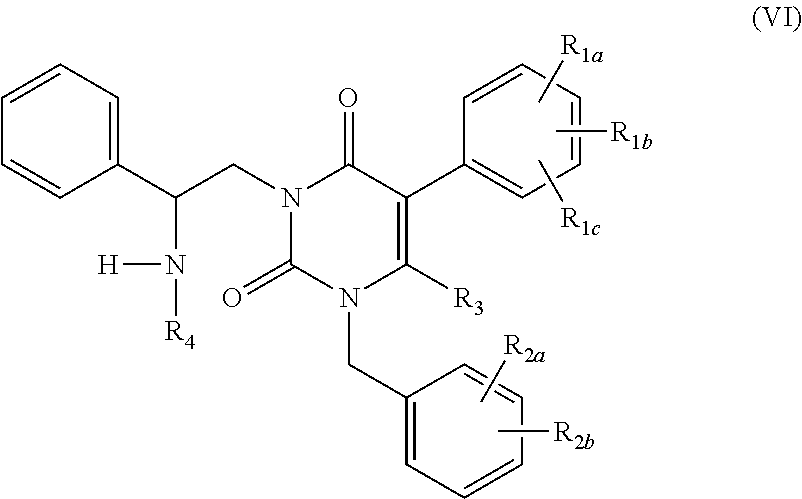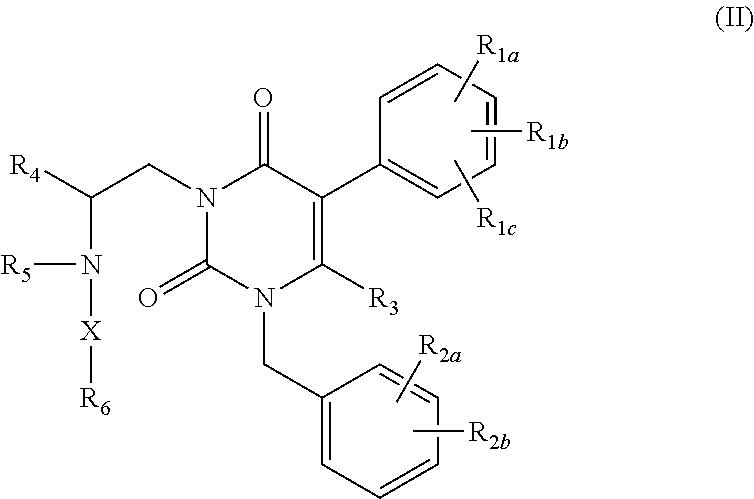Processes for the preparation of uracil derivatives
a technology of uracil derivatives and process steps, applied in the field of process steps for the preparation of uracil derivatives, can solve the problems of low bioavailability and adverse side effects of peptidic antagonists, low histamine release properties of peptidic antagonists, and clinical use of such antagonists
- Summary
- Abstract
- Description
- Claims
- Application Information
AI Technical Summary
Benefits of technology
Problems solved by technology
Method used
Image
Examples
example 1
[0039]
Step 1A: 1-(2-Fluoro-6-trifluoromethyl-benzyl)-6-methyl-1H-pyrimidine-2,4-dione
[0040](2-Fluoro-6-trifluoromethyl-benzyl)-urea (2.568 g, 10.9 mmol) in toluene (125 mL) was heated briefly to reflux under a Dean-Stark trap. T-butyl acetoacetate (5.0 g) was added and the mixture heated to reflux for 4 hrs. p-Toluenesulfonic acid monohydrate (2.82 g, 14.8 mmol) was added and the reflux was continued for one additional hour. Toluene was displaced with i-PrOH and the volume of the solution was reduced to approximately 30 mL. The solution was stirred overnight at room temp. The crystalline product was filtered and washed with a few mL of i-PrOH to provide 2.01 g (63% yield) of 1-(2-fluoro-6-trifluoromethyl-benzyl)-6-methyl-1H-pyrimidine-2,4-dione. LCMS (ESI) m / z 303.0 (MH+)
Step 1B: 1-(2-Fluoro-6-trifluoromethyl-benzyl)-5-iodo-6-methyl-1H-pyrimidine-2,4-dione
[0041]To a 250 mL three-neck round bottom flask was charged 1-(2-fluoro-6-trifluoromethyl-benzyl)-6-methyl-1H-pyrimidine-2,4-dion...
example 2
[0048]
Step 2A: Ethyl-2-(2′-fluoro-3′-methoxyphenyl)-glyoxylate
[0049]N,N,N′,N′,N″-Pentamethyldiethylenetriamine (PMDFT, 36.0 g, 43.5 mL, 208 mmol) and anhydrous tetrahydrofuran (THF, 150 mL) were charged into a 3-necked 1 L round bottom flask purged with N2. The solution was chilled to −78° C. with acetone—dry ice. Under continuous agitation and N2 purge butyllithium (Bu-Li, 1.6 M solution in hexanes, 130 mL, 208 mmol) was added to the solution. Over a period of 30-45 min. 2-fluoroanisol (13.1 g, 11.7 mL, 104 mmol) diluted with anhydrous THF (50 mL) was added to the Bu-Li solution. One hour after the addition of 2-fluoroanisol the reaction mixture was slowly transferred to another 3-necked 1 L round bottom flask containing diethyloxalate (100 mL, 107.6 g, 736 mmol) diluted with anhydrous THF (100 mL) at −78° C. under N2 purge. Agitation, −78° C. temp. and N2 purge were maintained during the transfer and for one hour after. 85% H3PO4 (85 mL) diluted with water (240 mL) was added and t...
example 3
[0054]
Step 3A: (Z)-2-(2-Fluoro-3-methoxy-phenyl)-3-phenoxycarbonylamino-but-2-enoic acid ethyl ester
[0055]Aminocrotonate 2e (5.0 g, 19.7 mmol), toluene (50 mL), calcium oxide (powdered, 2.5 g, 44.6 mmol), and phenyl chloroformate (3.4 g, 21.67 mmol) were combined in a reactor. The slurry was stirred at 75° C. for 10 hours. The mixture was cooled to 25° C. and filtered through a #1 filter paper. The reactor and cake were washed with 50-100 mL of toluene. The toluene solutions were combined and stripped off under a 10 mm vacuum to give 7.5 g of carbamate residue 3a.
Step 3B: N-{(R)-2-[5-(2-Fluoro-3-methoxy-phenyl)-4-methyl-2,6-dioxo-3,6-dihydro-2H-pyrimidin-1-yl]-1-phenyl-ethyl}-2,2-dimethyl-propionamide
[0056]DMF (anhydrous, 70 mL) was added to carbamate residue 3a (7.5 g, 19.7 mmol) and the mixture was cooled to 0° C. t-BOC-(1R)-amino-2-amino-1-phenylethane acetate salt (6.41 g, 21.6 mmol) was added followed by K2CO3 (4.08 g, 29.6 mmol). The mixture was stirred for ˜3 hours (all carba...
PUM
 Login to View More
Login to View More Abstract
Description
Claims
Application Information
 Login to View More
Login to View More - R&D
- Intellectual Property
- Life Sciences
- Materials
- Tech Scout
- Unparalleled Data Quality
- Higher Quality Content
- 60% Fewer Hallucinations
Browse by: Latest US Patents, China's latest patents, Technical Efficacy Thesaurus, Application Domain, Technology Topic, Popular Technical Reports.
© 2025 PatSnap. All rights reserved.Legal|Privacy policy|Modern Slavery Act Transparency Statement|Sitemap|About US| Contact US: help@patsnap.com



